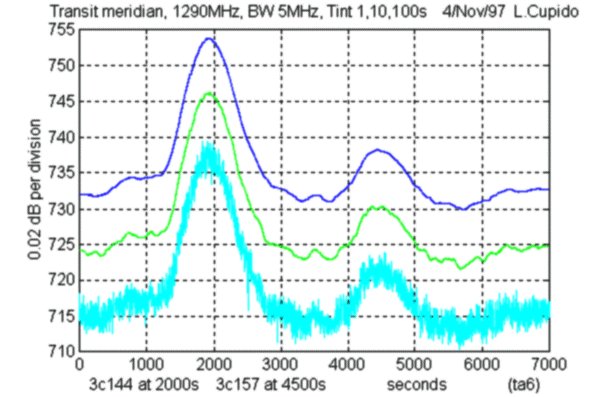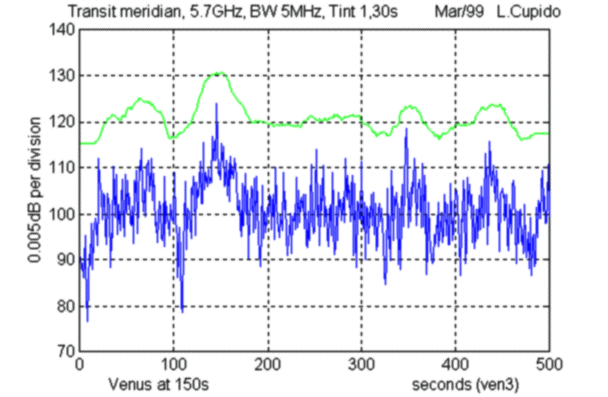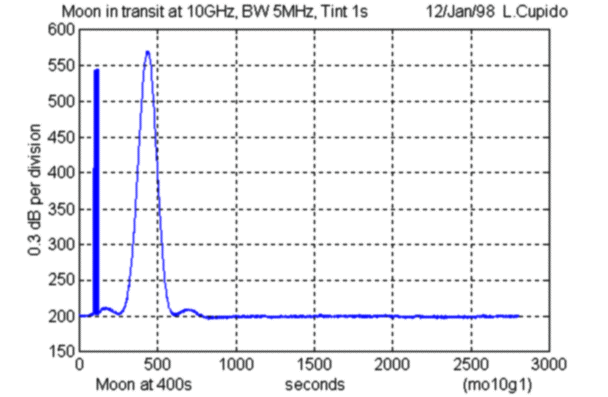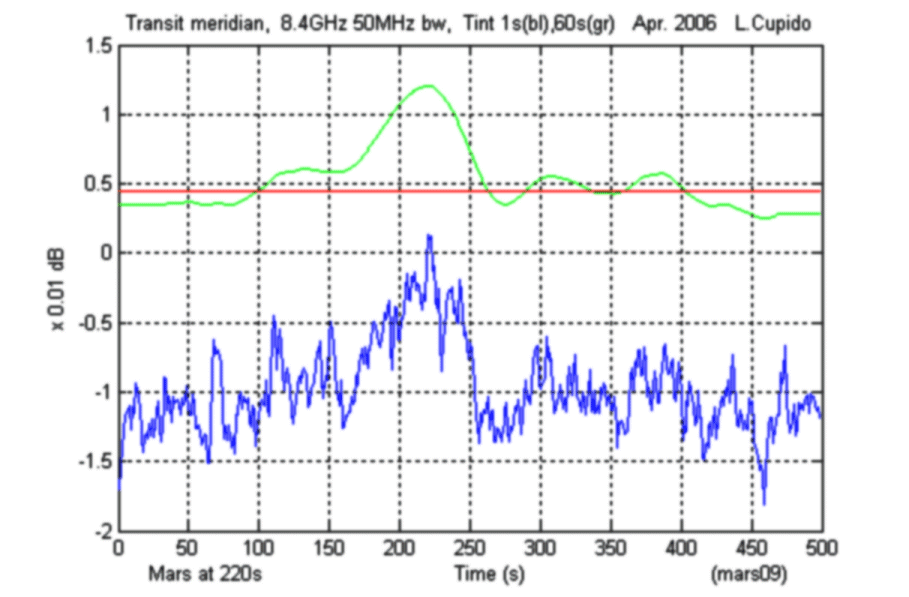The Orion nebula ( 3c145 ) at 24cm.

Orion A is a relatively strong source that has 520Jy at 21cm. It produces 0.2 K of antena temperature. At 2800s another source is observed but unidentified (by me !!! however it appears in several repeated scans at this exact position).
Taurus A ( 3c144 ) at 24cm.

Taurus A, the M1, is one of the most reliable sources in the sky for the purpose of system calibration. It is also one of the srongest sources in the sky with 875Jy at 21cm. I observe an antena temperature of 1.4 K. In the same scan we can see 3C157 (a supernova remnant) with 190Jy measuring about 0.5 K of antena temperature.
The W51 (or 3C400) nebula.

The W51 nebula ( 3C400 ) has 710Jy and produced 1.7Kelvin of antena temperature. This source is in the same declination of Vigo A and was very usefull to syncronise the integration of multiple scans of Virgo A (the M87 galaxy).
Venus at 6GHz, Thermal component is really weak.

Venus at 5.7GHz produced about 0.004 dB of noise increase at a system temperature of 150K. The corresponding antena temperature is 0.13K. Considering the antena beamwidth and Venus solid angle I can calculate a thermal venus with about 495K +/- 20K.
The moon at 10GHz, a real hot spot.

The moon at 10GHz is really a hot spot in the sky. It can produce more than 2dB that corresponds to an antena temperature of about 87Kelvin. The antena beamwidth (-3db points, and 55% of the energy) is about 0.5deg. (as the dish is intentionally underiluminated) while the moon has a subtended angle of about 0.5deg. From this we can deduct a real moon temperature of 160-180K, wich is not too far from the calibrated measurements that show 180-210K. The system noise temperature (in Jan 1998) was about 120K or even worst since I measure less then I should, quite bad I Know.
>>>>> The 3C273 Quasar. <<<<<

The strongest Quasar is still a weakie.
The 3C273 has 46Jy at 21cm and produced
about 0.05Kelvin of antena temperature, certainly the minimum signal I can measure
with this setup. More than 30 scans were done to obtain a clean one.
For such small signal variation measurement (below 0.01dB) all stability
details count. Even the lightest fog or the thinest
cloud could perturbate the measurement. Not to mention the temperature stability
of the radiometer and other components of the system.
There are just a few amateur detection of quasars. As far as I know 3C273 was detected with
single dish setups by me, Herman Hagn(DK8CI)(7.5m Wuerzburg-Riese dish) and
Robert W. Stephens (18m dish), and with interferometer setups by Hans Michlmayr(VK6ZT)(2x 5m dish)
and recently Jim Abshier(W8QOP)(2x 3m dish) who have also detected fainter
sources like 3C147/23Jy.
Jupiter at 10GHz, Extreemely hard to measure.

Jupiter at 10GHz produced about 0.0013dB of noise increase at a system temperature of 120K. The measured antena temperature was 0.037K. Considering the antena beamwidth and Jupiter solid angle I can calculate a thermal Jupiter of about 140K +/- 30K. For this measurement to be made I had to know the precise Jupiter's posistion scans and needed an extreemely stable atmosfere during the scan time. I've made a large number of scans (>50) to get one that passed smothly trougth Jupiter posistion. The signal presented is the very best I could obtain. (If you want to track down my calculations please note that at 10GHz my antena was (by Mar. 1999) a bit underiluminated, resulting in only 50.0 dB of gain, and 0.5 deg at -3dB points)
Mars at 8.4GHz, Easy to measure with help from MRO.

Mars at 8.4GHz produced about 0.006dB of noise increase at a system temperature of 45K (very low noise preamp at 8.4GHz and weeks of adjusting the antenna ilumination and spillover). This corresponds to an antena temperature of 0.062K. Considering the antena beamwidth and Mars solid angle I can calculate a thermal Mars of about 173K +/- 20K. To make this measurement I used the Mars Reconaisance Orbiter (MRO) signal to know the exact Mars position therefore only a few scans were required to produce this result. A stable atmosfere during the scan time was mandatory.
 Luis Cupido
Luis Cupido